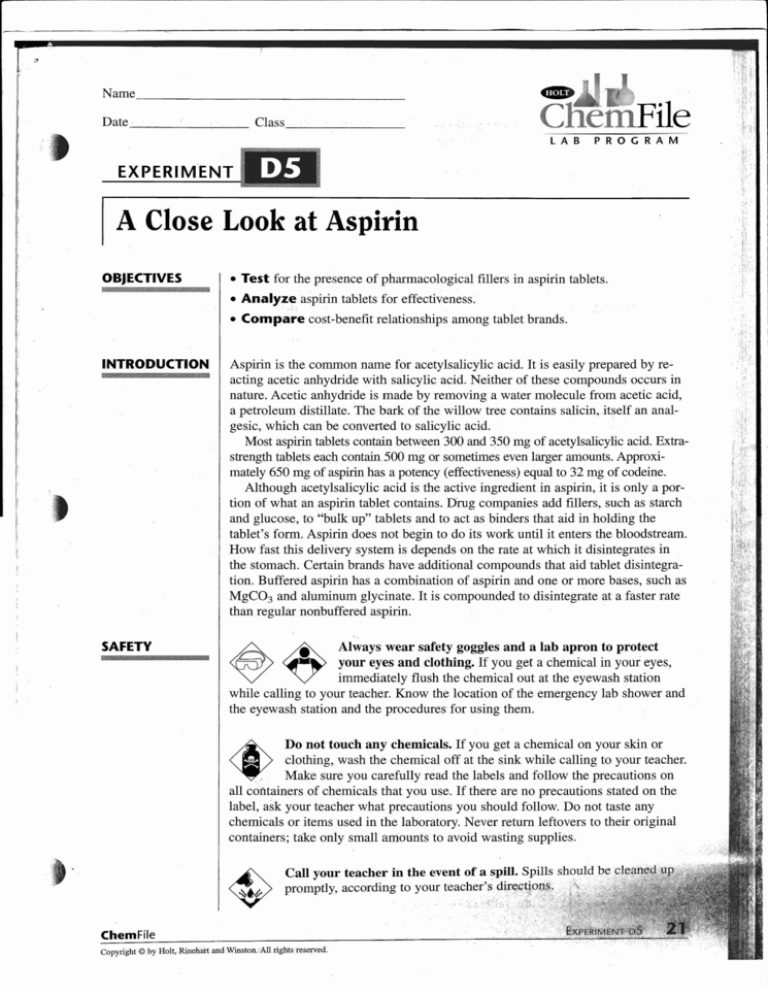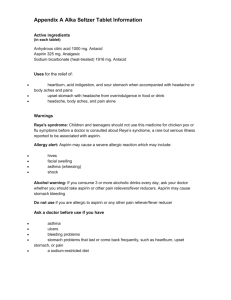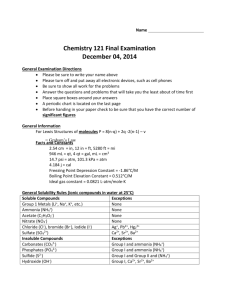
...----------------------------------------------~~----------
Name
_
Date _ _~_ _~_ _
_
Class~
LAB
PRO G RAM
.--~~
EXPERIMENT
i D5
I
1_•. ~~~.=>~ ,.on:
I A Close Look at Aspirin
OBJECTIVES
• Test for the presence of pharmacological fillers in aspirin tablets.
• Analyze aspirin tablets for
effectiveness~
• Compare cost-benefit relationships among tablet brands.
INTRODUCTION
SAFETY
Aspirin is the common name for acetylsalicylic acid. It is easily prepared by re­
acting acetic anhydride with salicylic acid. Neither of these compounds occurs in
nature. Acetic anhydride is made by removing a water molecule from acetic acid,
a petroleum distillate. The bark of the willow tree contains salicin, itself an anal­
gesic, which can be converted to salicylic acid.
Most aspirin tablets contain between 300 and 350 mg of acetylsalicylic acid. Extra­
strength table.tseach contain 500 mg or sometimes even larger amounts. Approxi­
mately 650 mg of aspirin has a potency (effectiveness) equal to 32 mg of codeine.
Although acetylsalicylic acid is the active ingredient in aspirin, it is only a por­
tion of what an aspirin tablet contains. Drug companies add fillers, such as starch
and glucose, to "bulk up" tablets and to act as binders that aid in holding the
tablet's form. Aspirin does not begin to do its work until it enters the bloodstream.
How fast this delivery system is depends on the rate at which it disintegrates in
the stomach. Certain brands have additional compounds that aid tablet disintegra­
tion. Buffered aspirin has a combination of aspirin and one or more bases, such as
MgC0 3 and aluminum glycinate. It is compounded to disintegrate at a faster rate
than regular nonbuffered aspirin.
•
~~
Always wear safety goggles and a lab apron to protect
your eyes and clothing. If you get a chemical in your eyes,
immediately flush the chemical out at the eyewash station
while calling to your teacher. Know the location of the emergency lab shower and
the eyewash station and the procedures for using them.
Do not touch any chemicals. If you get a chemical on your skin or
clothing, wash the chemical off at the sink while calling to your teacher.
. ..
'
Make sure you carefully read the labels and follow the precautions on
all cOiltainers of chemicals that you use. If there are no precautions stated on the
label, ask your teacher what precautions you should follow. Do not taste any
chemicals or items used in the laboratory. Never return leftovers to their original
containers; take only small amounts to avoid wasting supplies.
<t>
.Call your teacher in the event of a spill. Spills should bef~¢,~ed up
promptly, according to your teacher'sd.irlff.~~(j;tiS:;" )":",,,";
':
~,~, _ . ~~-(i_~_:':' "'-. :p~ . ;~._ ~~':~~~ ~~~"
ChemFile
Copyright ©by Holt, RinehiUtand WinstOli.'All rights reserved.
';' .
.~ :
EXPERIMENT D5 continued
Never put broken glass in a regular waste container. Broken glass
should be disposed of properly.
When using a hot plate, do not heat glassware that is broken,
chipped, or cracked. Use tongs or a hot mitt to handle heated glassware
and other equipment because hot glassware does not always look hot.
MATERIALS
PROCEDURE
• 5 different generic and
name-brand aspirin tablets
• Benedict's solution
• 1% FeC13 solution
• Lugol's iodine
• saturated NaC0 3
• 10 mL gracluated cylinder
• 25 mL graduated cylinders
.500 mL beaker
• centigram balance
• hot plate
•
•
•
•
•
•
•
•
•
medicine droppers or micropipets
microspatula
mortar and pestle
plastic (1 oz) cups
test-tube clamp
test-tube rack
test tubes
universal pH test paper
wax pencil
Part 1: Testing for the presence of tablet fillers
1. Obtain a set of five cups and label them 1 to 5. Place three tablets of a differ­
ent brand/type of aspirin in each labeled cup. Record the manufacturer's
name and the strength (amount) of acetylsalicylic acid in Data Table 1. The
amount of active ingredient is reported in· either grains or milligrams. Com­
plete Calculations item 1.
2. For each sample tested, determine the mass to the nearest 0.001 g of a single
tablet. Record these values in Data Table 1. Complete Calculations items 2
and 3.
3. Prepare a water bath by adding approximately 250 mL of tap water to a
500 mL beaker. Set the beaker on a hot plate. Heating on medium, bring the
water to a slow boiL Complete steps 4 through 10 while waiting for the
water to boiL
Part 2: Testing for filler/binder components
4. Using the wax pencil, label five test tubes 1-1,2-1,3-1,4-1, and 5-1. Place
the tubes in a test-tube rack.
5. Label ten small cups 1-2, 1-3,2-2,2-3,3-2,3-3,4-2,4-3,5-2, and 5-3.
6. Measure 15 mL of distilled water in a graduated cylinder. Crush 2 tablets of
sample 1 using a mortar and pestle. Use a microspatula to transfer the pow­
dered material to the graduated cylinder. Carefully place your thumb over the
top of the cylinder and shake gently to dissolve the aspirin. Pour 5 mL of the
mixture into test tube 1-1 and 5 mL each into cups 1-2 and 1-3.
7. Repeat step 6 for brands 2 through 5.
8. pH Test Dip a piece of pH paper into one of the cups from Step 6. Record
the value in Data Table 1.
22
EXPERIMENT D5
ChemFile
Copyright© by Holt, Rinehart and Winston. All rights reserved.
EXPERIMENT DS continued
9. Sugar Test To test tube 1-1, add a single drop of saturated NaC0 3 . Gently
swirl the test tube to mix. Use universal pH paper to test for a neutral pH.
Repeat the drop-by-drop addition of NaC0 3 solution until the pH equals 7.0.
10. Add 5 mL Benedict's quantitative solution to the test tube from step 9.
1 t. Using a test-tube clamp, carefully place the test tube from step 9 in the w.ater
bath for at least 5 minutes.
12. Using a test-tube clamp, remove the test tube from the water bath, and place
it in the test-tube rack. If the color of the mixture changes to red, orange, or
yellow, reducing sugars are present. Place a check mark next to "glucose" in
Data Table 1. The darker the color is, the greater the amount of sugar pre­
sent.A precipitate may also be present for a positive test.
13. Repeat steps 8 through 12 for the other aspirin samples.
14. Test for Starch Add five drops of Lugol's iodine to each of the samples in
cups 1-2,2-2,3-2,4-2, and 5-2. Gently swirl each cup to mix the iodine so­
lution and the sample. If a blue-black color forms, place a check mark next
to "Starch" in Data Table 1.
15. Test for Excess Salicylic Acid Add 10 drops of 1% FeCl 3 to each of the
samples in cups 1-3,2-3,3-3,4-3, and 5-3. Gently swirl each cup to mix the
FeCl 3 reagent and the sample. A pink, light purple, or green color indicates
the presence of excess salicylic acid. Record your results in Data Table 1.
Data Table 1-Aspirin Analysis
Sample
number
Strength
of active
ingre­
dient
Mass
of
tablet
(g)
Percent­
age
fillerl
binder
pH
Compo­
sition
of fillerl
binder
Presence
of excess
salicylic
acid
(g)
Brand 1
Starch [ ] Yes [ ]
Glucose [ ] No [ ]
Brand 2
Starch [ ] Yes [ ]
Glucose [ ] No [ ]
Brand 3
Starch [ ] Yes [ ]
Glucose [ ] No [ ]
Brand 4
Starch [ ] Yes [ ]
Glucose [ ] No [ ]
Brand 5
Starch [ ] Yes [ ]
Glucose [ ] No [ ]
ChemFile
Copyright © by Holt, Rinehart and Winston. All rights reserved.
Time
needed
to
dissolve
(min)
EXPERIMENT D5
23
EXPERIMENT D5 continued
.Part 3: Analyzing aspirin tablets ·for effectiveness
16. Use a wax pencil to label five clean, dry test tubes 1 to 5. Place the tubes in
a test-tube rack.
17. Pour 10 mL of 1 M HCI into each test tube.
18. Place a single tablet of each sample to be tested into its respective numbered
test tube. Record the time it takes to fully dissolve in Data Table 1. Why is
1 M HCI, rather than some other acid, used to dissolve the tablets?
Part 4 Determining cost effectiveness
19. Obtain from your teacher consumer information sources for generic, name
brand, and extra-strength aspirin tablets. Use this information to complete
columns 1,2,3, and 5 in Data Table 2. Complete Calculations steps
4 and 5.
Cleanup and Disposal
20. Clean all apparatus and your lab station. Return equipment to its
~
~
proper place. Dispose of chemicals and solutions in the containers
designated by your teacher. Do not pour any chemicals down the
drain or put them in the trash unless your teacher directs you to do
so. Wash your hands thoroughly after all work is finished and be­
fore you leave the lab.
Data Table 2-Analyzing and Comparing Tablet Cost vs. Value
Brand
Z4
Number of Package cost
tablets per
package
EXPERIMENT
D5
Cost per Amount of active Cost per mg
tablet
ingredient (mg)
of active
ingredient
ChemFile
Copyright ©by Holt, Rinehart,and Winston. All rights reserved.
EXPERIMENT D5 continued
CALCULATIONS
1. Organizing Data Convert the mass of the reported active ingredient
for each sample to grams. Enter each result in column 1 of Data Table 1.
1 mg = 0.001 g, and 1 gr = 64.8 mg. Note: A grain (gr) is the smallest
apothecary measure of weight.
2. Organizing DClita Calculate the mass of filler/binder in each tablet by
subtracting the mass of the active ingredient from the mass of the tablet.
3. Organizing Data Determine the cost per tablet for each type of aspirin
tablet by dividing the package cost by the number of tablets per package.
Enter your results in column 4 of Data Table 2.
4. Organizing Data To determine the cost per milligram of active ingredi­
ent for each tablet, divide the cost per tablet by the number of milligrams of
active ingredient. Enter your results in column 6 of Data Table 2.
I~
QUESTIONS
1. Applying Conclusions Explain why the pH measurements of the tested
aspirin tablets are so close together.
2. Analyzing Data Which filler predominates in the aspirin tablets tested,
starch or glucose?
ChemFile
Copyright © by Holt, Rinehart and.Winston. All rights reserved.
EXPERIMENT
DS
25
I;
EXPERIMENT ~Q~. c-t{ftl'inued
."'; I.,.~_ . • ;
~
",~,,3.
" ,:
Analyzing Data, How uniform are the masses of tablets for aspirin
tablets having 325 mg of active ingredient?
'.
..
~.~
,
.
4. Analyzing Data and Inferring Conclusions Suggest an explana­
tion for why excess salicylic acid might be present in aspirin tablets.
5. Analyzing Data Review the times recorded for each tablet to dissolve.
Which brand was most effective in reaching the bloodstream?
1. Analyzing Information Review column 6 in Data Table 2. This col­
GENERAL
CONCLUSIONS
umn is the cost per milligram of acetylsalicylic acid. Is it worth paying more
money for extra~Strength tablets? How does the mass of acetylsalicylic acid
in three regular-strength aspirin tablets compare to that in two extra-strength
aspirin tablets?
2. Inferring Conclusions Why does the packaging of some aspirin tablets
list active ingredients bther than acetylsalicylic acid?
26
EXPERIMENT
D5
ChemFile
Copyright © by Holt, Rinehart and Winston. All rights reserved.






